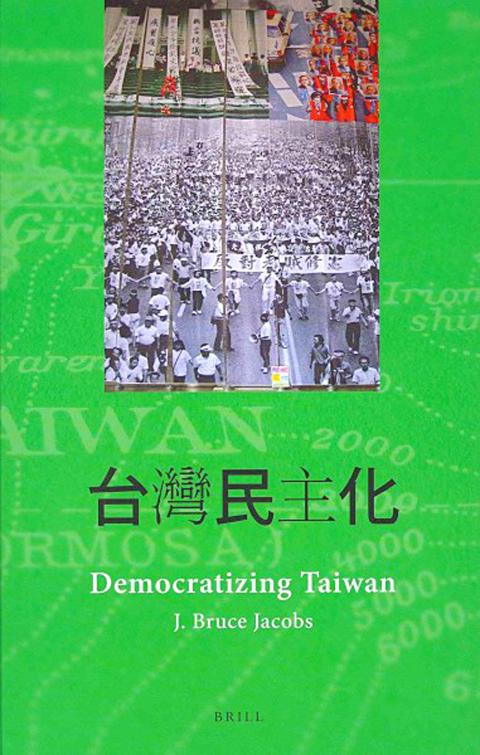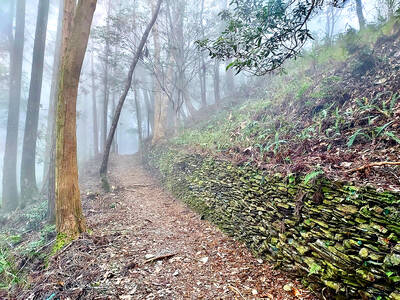Longtime Taiwan watcher Bruce Jacobs is back with a book that looks at the minutiae of Taiwan’s long journey from colonial property, authoritarian subject to imperfect democracy, in a work that makes a solid contribution to the field of Taiwan studies.
It is important to establish from the outset what Democratizing Taiwan is and what it isn’t. What it isn’t is a scholarly volume on how Taiwan democratized, or to what extent the various conditions that are essential to the emergence of democracy interacted to allow the country’s 23 million people to transition peacefully from authoritarian rule to democracy. While Chapter One, How Taiwan Became Democratic, briefly addresses the matter and endeavors to distinguish between democratization and liberalization and does highlight some of the-then factors that led to democratization, readers who seek in-depth research into democratic development in Taiwan will have to look elsewhere.
What it also isn’t is a comparative study of Taiwan’s democratization, which would shed light on why Taiwan democratized when it did, and why other countries that have achieved similar standards of living didn’t go down the same path, or did so later on. Although Jacobs briefly contrasts Taiwan’s experience with that of South Korea, a much longer discourse is necessary, and in fact would be enough in itself to constitute another book.

But comparisons and contrasts isn’t what Jacobs, a professor of Asian languages and studies at Monash University in Melbourne, Australia, set out to do with Democratizing Taiwan.
The title of the book itself is key to understanding the nature of Jacobs’ work, as it simultaneously points to a descriptive narrative of Taiwan in the process of democratization — in other words, a blow-by-blow account of who did what, when and who won elections by how many percentage points — and to a prescriptive work on how to deepen democracy in Taiwan. While the book is largely descriptive, using newspaper reports or on-scene accounts by Jacobs, ever the hands-on type of academic, inter alia it makes a strong case on how to win, and not to win, future elections — a signal that is especially relevant to the opposition Democratic Progressive Party (DPP).
Although the chapters are relatively brief, each manages to extract the essentials of the period being scrutinized, whether it is that of the Japanese or Chinese Nationalist Party (KMT) regimes — which he both terms “colonial” — or the Lee Teng-hui (李登輝), Chen Shui-bian (陳水扁) and Ma Ying-jeou (馬英九) presidencies, which constitute the three main parts of the book (the narrative ends in late 2011, prior to the January 2012 presidential election).
For that reason alone, the numerous tables in the book on voting outcome in legislative, local and presidential elections provides a valuable, one-stop resource for any student or academic focusing on electoral developments here. What the book makes clear through use of such data is that while “Mainlanders” often tend to vote along ethnic lines, Taiwanese are far more likely to cast their vote along issue-oriented lines, which is the only way to explain why, despite representing a small minority of Taiwan’s population, the KMT’s “Mainlanders” have performed so well in one election after another. It also becomes clear that pragmatic issues, rather than relations with China, sovereignty or identity, are the chessboard upon which elections are won and lost.
While allowances should be made for other factors that have historically given the KMT an advantage over the opposition, such as money, Jacobs makes a strong case for issues-based electoral outcomes, and has plenty of numbers to support his argument.
Jacobs’ account of the splits and alliances that formed ahead of important elections is unlikely to have much appeal outside academic circles that look specifically at Taiwan. But for those of us who do, it serves as a useful reminder that despite the seemingly insurmountable blue-green divide that characterizes Taiwanese politics today, cooperation between parties on specific issues did occur and could occur again, which serves as another lesson for those who argue that cooperation with the KMT is impossible.
Democratizing Taiwan also succeeds in describing the process of change that occurred under Lee and Chen, especially in the reorganization of the legislature, voting systems, constitutional amendments, and the restructuring of government agencies.
While it is often convenient to accuse Chen of all kinds of ills, there nevertheless is little doubt that his administration played no small role, especially after 2004, in transforming the civil service into one that serves whoever is in power rather than a specific political party, something that can also be said of the armed forces, despite Chen’s difficulty in winning their trust. This aspect of Chen’s presidency, though often overlooked, was one of the milestones of Taiwan’s democratic consolidation.
Of the three latter sections, those on Lee and Chen are the strongest and that on Ma the weakest, probably because the Ma presidency is still a work in progress, and we don’t have the benefit of time and hindsight to make a full account of his failures and successes.
Still, the author makes his view clear that the rapid reform seen under Lee and Chen has lost momentum under Ma. Conversely, Jacobs’ admiration for Lee’s ability to work within the KMT and to launch Taiwan on the road to democracy is evident, though he nevertheless manages to make it clear that Lee’s efforts alone were insufficient to create a democracy in the true sense of the word, if only because he ran out of time and had to step down in 2000.
His section on Chen, above-mentioned accomplishments aside, is especially relevant in what it tells about the DPP’s inability to appeal to the majority of Taiwanese, both during the Chen presidency and since 2008, when the KMT regained power in the country’s second peaceful change of the guard. Resisting the temptation to dictate how the DPP or other parties should approach future elections, Jacobs nevertheless provides ample evidence to discredit the view that a DPP win is by now mathematically impossible because of gerrymandering, a “free but not fair” system, or growing Chinese influence. Against all odds, Chen won in 2000 and again in 2004, and there is no reason why the DPP could not do so again — provided the party shows a willingness to honestly revisit the recent past and to recognize what went wrong. More of the same, Jacobs tells us between the lines, is a sure recipe for failure.
While we still have to wait for the definitive work on Taiwan’s democracy, Democratizing Taiwan is an important, and eminently accessible, addition to a relatively small body of literature that looks specifically at the unique experiment that is Taiwan’s emergence as a democracy.

The 1990s were a turbulent time for the Chinese Nationalist Party’s (KMT) patronage factions. For a look at how they formed, check out the March 2 “Deep Dives.” In the boom years of the 1980s and 1990s the factions amassed fortunes from corruption, access to the levers of local government and prime access to property. They also moved into industries like construction and the gravel business, devastating river ecosystems while the governments they controlled looked the other way. By this period, the factions had largely carved out geographical feifdoms in the local jurisdictions the national KMT restrained them to. For example,

The remains of this Japanese-era trail designed to protect the camphor industry make for a scenic day-hike, a fascinating overnight hike or a challenging multi-day adventure Maolin District (茂林) in Kaohsiung is well known for beautiful roadside scenery, waterfalls, the annual butterfly migration and indigenous culture. A lesser known but worthwhile destination here lies along the very top of the valley: the Liugui Security Path (六龜警備道). This relic of the Japanese era once isolated the Maolin valley from the outside world but now serves to draw tourists in. The path originally ran for about 50km, but not all of this trail is still easily walkable. The nicest section for a simple day hike is the heavily trafficked southern section above Maolin and Wanshan (萬山) villages. Remains of

With over 100 works on display, this is Louise Bourgeois’ first solo show in Taiwan. Visitors are invited to traverse her world of love and hate, vengeance and acceptance, trauma and reconciliation. Dominating the entrance, the nine-foot-tall Crouching Spider (2003) greets visitors. The creature looms behind the glass facade, symbolic protector and gatekeeper to the intimate journey ahead. Bourgeois, best known for her giant spider sculptures, is one of the most influential artist of the twentieth century. Blending vulnerability and defiance through themes of sexuality, trauma and identity, her work reshaped the landscape of contemporary art with fearless honesty. “People are influenced by

Ten years ago, English National Ballet (ENB) premiered Akram Khan’s reimagining of Giselle. It quickly became recognized as a 21st-century masterpiece. Next month, local audiences get their chance to experience it when the company embark on a three-week tour of Taiwan. Former ENB artistic director Tamara Rojo, who commissioned the ballet, believes firmly that if ballet is to remain alive, works have to be revisited and made relevant to audiences of today. Even so, Khan was a bold choice of choreographer. While one of Britain’s foremost choreographers, he had never previously tackled a reimagining of a classical ballet, so Giselle was